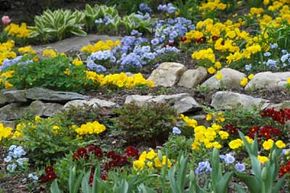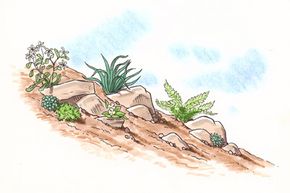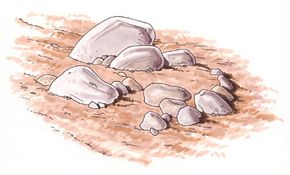There are rock garden styles to suit every taste, but great care must be taken that the style chosen suits the site. For example, a huge mound of rocks rising out of nowhere will look very much out of place in a grassy lawn. Flat, craggy limestone, while attractive in its own right, will not suit a yard dominated by a fieldstone house. Remember, a rock garden is essentially a re-creation of a mountain slope. Picture this in your mind and try to create it on a scale that suits your growing space.
The easiest rock garden to plan is always a natural one. If your garden has a natural stone outcropping, you can easily bring out its beauty by cutting back invasive roots, removing a few shrubs and trees to increase sunlight, and possibly digging away some soil to better reveal the natural rock. Even a small rock outcropping can be used to advantage by adding similar rocks to repeat and accentuate the original pattern.
Slopes are ideally suited to rock gardens. Not only are they hard to maintain otherwise (just ask anyone who has tried to mow a hillside lawn) but it is also easy to integrate rocks into a slope and make it look as though they were put there by Mother Nature. Flat surfaces are not obvious choices for a rock garden, but don't rule them out entirely. The next few pages will suggest ways of creating a successfully integrated rockery even in a flat area.
Generally speaking, rock gardens should be placed in full sun; most plants you'll use in a rock garden love sunlight. Although you can create an attractive rock garden in a shady spot, your plant choices will be more limited.
Perhaps no other step is as important in planning a rock garden as choosing the right rocks. All too often, a "rock garden" consists of a pile of rounded river stones of various sizes and colors randomly strewn on the ground: Nothing could look more artificial! Instead, use rocks that are uniform in color and texture; ideally, they should be angular in shape with distinct lines or strata. If these similar rocks are placed at roughly the same angle, it will look as though Mother Nature deposited them.
Rounded rocks, however, need not be banished from the rock garden, but they should be similar in color and texture. For a natural look, set the first ones quite deeply in the ground. As more rocks are added, make sure that about half of each rock is hidden from sight.
Make sure some of the rocks are very large ones: true boulders. These larger rocks are the keystones of the rock garden. One rule of thumb: If it can be moved by one person, it's too small. Once the boulders are in place, medium-size rocks can be added. Smaller rocks will be needed to fill in any gaps.
Rock gardens are also ideal sites for waterfalls. Even a steady stream of water droplets landing in a tiny pond at the garden's base will do. In fact, smaller waterfalls are often the best choice for the home rockery: large cascades of frothy, foaming water are for very massive rock gardens.
Learn how to build a rock garden in the next section.
Want more information about rock gardens? Try these:
- Rock Gardens: Learn about these unique and functional gardens.
- Rock Garden Plants: Learn about the special plants that make up rock gardens.
- Garden Types: Explore a variety of wonderful garden types.
- Gardening: We answer all of your general gardening questions in this section.



